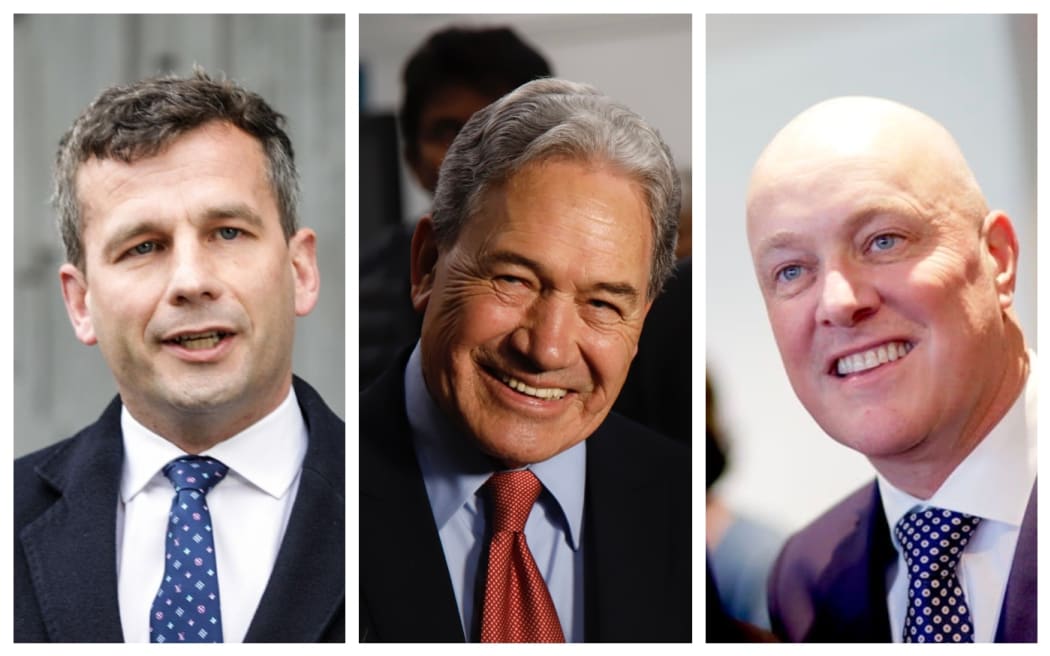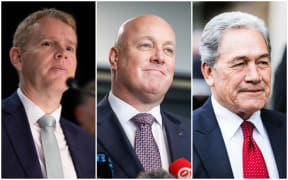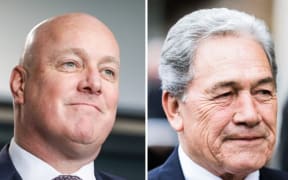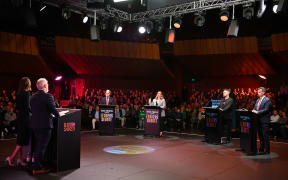
ACT leader David Seymour, NZ First leader Winston Peters and National leader Christopher Luxon. Photo: RNZ
Analysis - "There's never been an election where the main polling companies have got it wrong."
That was Murray Campbell, director of Research Association New Zealand, quoted in a recent article published by the Herald.
If that holds true on Saturday a National-led government will be elected, either in coalition with ACT or, more likely in recent polls, in coalition with ACT and NZ First.
The polls have shown Labour, the Greens and Te Pāti Māori well short of the 61 seats needed for a majority, and there haven't been any significant changes.
"This campaign is flatlining," said pollster and strategist Dr Michael Turner in a Stuff report published on Monday.
"There's no denying it, very few minds have been changed so far. With a week to go until party hacks can put down their placards, the opinion polls look much the same as when they were first picked up."
Turner said, however, that one thing had struck him - the number of people who were "holding back".
In August around 9 percent of voters were saying they were undecided, and in more recent polls the figure had been 10 percent, he said.
"That figure should be going down, not up. There remains an election-winning bloc of 'floating voters'." Turner put the number at around 300,000.
The Herald's head of data journalism, Chris Knox, said if current predictions were accurate and voters didn't change, National, ACT and NZ First would be in a position to form a government.
"But within the margin of error or given that people's voting intentions can change even within a week or so, then a relatively small change is needed to go from where the polls are predicting the outcome will be now, to Labour actually being in power," he said.
Knox said the biggest impact on the outcome was whether NZ First reached the 5 percent threshold. "If it didn't make it, and there was a small shift in support from right to left, it would make it easier for Labour to form a government."
In the same article, which was also published on Monday, Audrey Young said Labour, the Greens and Te Pāti Māori did have a narrow path to power "but it would almost certainly have to involve New Zealand First falling just under the 5 percent threshold".
In recent weeks NZ First has been slowly but steadily gaining support, and is considered to have been helped by National Party leader Christopher Luxon saying he would work with Winston Peters after the election if he had to.
The party has been consistently above 5 percent.
Since Luxon made his announcement National has become alarmed by the prospect of actually having to include NZ First in a coalition.
"Perhaps realising he had given National supporters 'permission' to vote for New Zealand First, Luxon then slammed on the brakes and highlighted how much he did not want to work with Winston Peters," Young said.

Christopher Luxon Photo: RNZ / Marika Khabazi
National has been running ads aimed at scaring voters away from NZ First and even saying there might have to be another election if it couldn't reach an agreement with Peters.
The NZ First leader described that as "bovine scatology" (BS).
RNZ's poll of polls clearly shows in its graph the progress NZ First has made, while at the same time ACT's support has declined.
ACT leader David Seymour last week said it was 'a huge worry" that support for the right bloc had been trending down in the last four 1News-Veriant polls.
Death of ACT candidate leads to by-election
A very unusual aspect to this election has been caused by the death of ACT's Port Waikato candidate Neil Christensen.
A by-election will be held on 25 November to choose an MP for Port Waikato. Party votes cast in the general election will be counted, but not the candidate votes.
Law professor Andrew Geddis, in an article for RNZ, explained what would happen and why the process was considered to help National.
"Port Waikato voters will elect their local electorate MP," he said.
"This MP will be 'extra' to the 120 seats already allocated by the Electoral Commission after the general election. And one of the candidates will be Andrew Bayly, standing for the National Party."
Bayly is assured of getting in before that because he is number 15 on National's list.
He will then stand as the electorate candidate on 25 November, and is expected to easily retain the safe National seat.
At that point, Geddis said, Bayly would resign his list seat and re-enter Parliament as Port Waikato's electorate MP "while the National Party gets allocated another list seat to make up for the one that it 'lost' when he resigned".
"In short, the legally required by-election process means National is basically guaranteed getting another seat in Parliament quite shortly after the final results of the general election are announced," Geddis said.
"Meaning that the magic number of seats it and ACT now need to get between them from the general election in order to avoid having to deal with New Zealand First is 60, rather than 61."
In his article Geddes said the rule was a throwback to the old pre-MMP days, when winning an electorate was the only way to get into Parliament.
"It might be time to rethink the rule at play here," he said.
"Not for this election - it must play out as the law requires - but whether this ought to happen again in future elections really is questionable."
Geddis' full article is on RNZ's website titled 'An extra Port Waikato seat in Parliament: What you need to know'.
*Peter Wilson is a life member of Parliament's press gallery, 22 years as NZPA's political editor and seven as parliamentary bureau chief for NZ Newswire.






